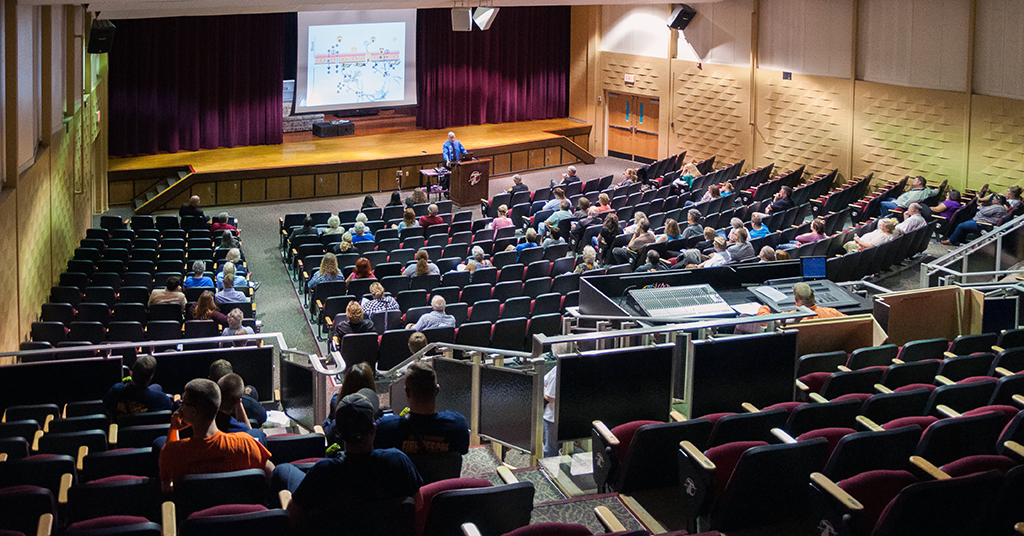Clark County residents frequently express concerns and rage that drug use, particularly heroin, seems to have struck the local area with a vengeance in recent years.
Frustration with the problem has reached a fever pitch.
Stories of Ohio’s “hopeless drug epidemic” are common. Arguments sear across social media over whether or not taxpayer monies should be used to provide law enforcement with the opioid-blocker Narcan to revive “hopeless heroin junkies” in “hopeless situations.”
However, according to speakers at the fifth annual Clark County Drug Symposium on Sept. 21, the situation is anything but “hopeless.”
Ohio Attorney General Mike DeWine, Clark County Sheriff Gene Kelly, and keynote speaker Dr. Brad Lander (clinical director of addiction psychiatry at the Ohio State University Wexner Medical Center), all say hope can be found in the midst of the tragedies caused by drug addiction.
DeWine introduced the new educational video his team created around the story of 16-year-old Tecumseh High School Student, Cole Ryann Smoot, who died in 2011 after overdosing on Methadone prescribed to someone else. DeWine stresses that Cole’s story shows that the drug epidemic is something that can touch anyone, any family, anywhere.
Teens and people in their 20s is the group most likely to try drugs for the first time, the Attorney General’s office has seen addicts up to 60-years old and older...shattering the idea that all addicts are young adults.
“It’s simply this. This is not an epidemic happening in someone else’s backyard, or in someone else’s community, or in somebody else’s part of town...This is in every part of town and in every county in the state of Ohio.
The Attorney General says it is important to not get wrapped up in numbers, and instead, to look for hope.
“We can talk about stats...who has died...how bad it is. But there is hope. People are being saved every day. But (the drug problem) won’t go away overnight.”
Heroin remains the drug of choice for many users, but recently there has been an increase in the use of Carfentanil, which is used as an elephant tranquilizer. Prescription drug abuse is high and the use of meth and speed are making a comeback in Clark County.
DeWine says he believes prevention is the key to stopping the drug epidemic, and that it has to start in childhood with programs for kindergarten through high school students. He also said local educational meetings and programs such as the symposium and the “Cole’s Warriors” initiative started by Smoot’s parents will increase prevention as well.
Kelly echoed the Attorney General’s suggestions on youth drug use prevention, citing programs like the successful DARE program in schools.
Kelly also mentioned how the county is taking a three-pronged approach to deal with the drug epidemic. Enforcement, education, and treatment are helping fight the county’s drug issues. Kelly also mentioned a drug take-back program that netted 315,000 pills in four hours, a new Clark County drug task force, and why a deputy saving two overdose victims on consecutive nights was so important.
“We have to have hope...more people to tell their stories, how and where to get help, and knowing there are people to stand with them,” says Kelly.
Dr. Brad Lander works with addicts every day, yet says he was “probably the most optimistic person in the room.”
“If you want to see miracles, you should be in my job...because we see them all the time,” says Lander.
Lander presented the science behind drug addiction. He also says he has seen different trends in drug use, but that opiates “really have us by the throat.”
Lander explained how drugs literally changes how the brain works and what it focuses on. Lander says this is why it is important to remember that the addict is “always doing the best they can,” given the physical changes that drugs wreak on their brain chemistry.
“Those chemical changes mean your reality isn’t the same as the reality of (an addict),” says Lander, holding up two fingers. “You see ‘two’ and know it’s ‘two,’ but the (addict) sees ‘three.’”
But Lander also related the miracles of people who have turned their lives around, who have stayed sober for years. He says it’s those victories that make helping addicts and continuing the fight against drug use so important.
“I had one guy six times...but now he’s sober and has his own place. He’s even getting his band back together. He’s doing just great.”
Dwan Hodges, a recovering addict, says he has a lot to be grateful for.
“I am a recovering drug addict...and I thank God I live in a society that accepts that we can get clean, that we can maintain a clean life, and be an asset to society. There are things and resources I have in me that I can give to another...and untapped and unexplored resources is a waste of a human life.”
Amy Cost of the Miami County Recovery Council also spoke and gave attendees some tips on what communities can do to help people with addiction issues, and why it is so important to work together to do it.
“Addiction doesn’t have walls, it doesn’t have boundaries, it doesn’t take a certain group, a certain age. (Addicts) all took different paths to get to the same place they are now...lost. When you’re lost, you don’t know how to get yourself out of it. It takes a whole community to do that, it takes all sections...police, firefighters, family members, recovery help. Everyone is affected by this epidemic and it takes everyone to come together to help the addict find their way back.”
The symposium was hosted by Family and Youth Initiatives (FYI) and took place in the Tecumseh High School auditorium.


